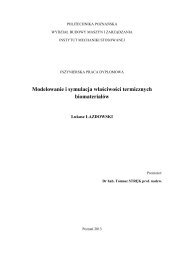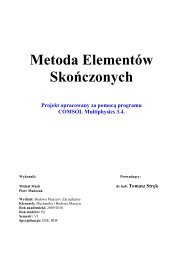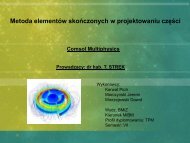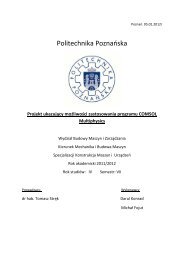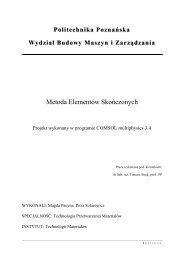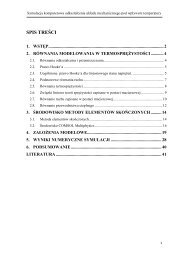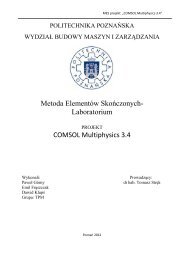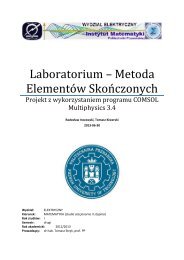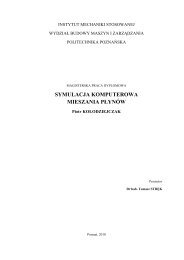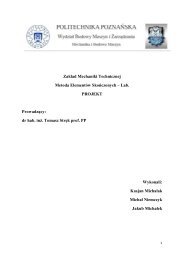Lithium-Ion Battery Simulation for Greener Ford Vehicles
Lithium-Ion Battery Simulation for Greener Ford Vehicles
Lithium-Ion Battery Simulation for Greener Ford Vehicles
You also want an ePaper? Increase the reach of your titles
YUMPU automatically turns print PDFs into web optimized ePapers that Google loves.
ENERGY<br />
RIELLO BURNERS, LEGNAGO, ITALY<br />
The Burning Need <strong>for</strong> Modeling<br />
BY GIANLUCA ARGENTINI, RIELLO BURNERS, LEGNAGO, ITALY<br />
When we think about heating and<br />
cooling, we often neglect to consider<br />
the energy consumed by components<br />
we take <strong>for</strong> granted such as fans, whether<br />
<strong>for</strong> distributing air into a room or <strong>for</strong><br />
feeding it into a burner <strong>for</strong> combustion.<br />
The energy consumed by fans depends on<br />
many aspects, but in a high-power burner<br />
(> 1 MW) the percentage of energy consumed<br />
by fans is about 30 – 40% of the<br />
total needed to run the system, which can<br />
range from 150W <strong>for</strong> a small ventilator to<br />
25 kW <strong>for</strong> a large burner. In fact, in residential<br />
and domestic burners (up to 100<br />
kW thermal power), due to small geometries,<br />
the percentage can be much higher,<br />
with up to 80% of the electrical energy <strong>for</strong><br />
the system consumed by fan.<br />
In addition, new ecology regulations<br />
in EU Directive 125/2009 addressing<br />
fans <strong>for</strong> industrial purposes fixes limits<br />
of about 40 – 50% <strong>for</strong> fan power consumption,<br />
putting additional pressure on<br />
manufacturers to improve their products.<br />
There is, in fact, great potential <strong>for</strong> saving<br />
energy as well as manufacturing costs<br />
in a well-designed fan, and here modeling<br />
plays a very important role because it not<br />
only saves considerable engineering time<br />
but also results in optimal designs. By reducing<br />
power consumption, it is possible<br />
to use a smaller motor to obtain the same<br />
per<strong>for</strong>mance. Other benefits include reducing<br />
the overall weight of burners and<br />
improved design of the components in the<br />
combustion head.<br />
This type of continual development is<br />
part of our job at Riello Burners. We are<br />
an internationally active company in the<br />
fields of oil and gas combustion, ventilation<br />
systems and hydraulic pumping. Our<br />
headquarters and main production facility<br />
is in Legnago near Verona, Italy, and<br />
we employ roughly 600 people. In terms<br />
of burners, we manufacture high-efficiency<br />
low maintenance burners with capacities<br />
from 10 kW to 32 MW, and they are<br />
used in the full range of residential and<br />
commercial heating applications as well<br />
as in industrial processes.<br />
Two Key Components<br />
The ventilating structure is fundamental<br />
to a burner because it ensures a continuous<br />
and appropriate flow of air into<br />
the combustion head where the flame is<br />
located. There are two principle ventilation<br />
components: the rotating wheel<br />
or impeller, and the external chassis in<br />
which it operates, and this is also called a<br />
volute. The basic challenge when designing<br />
a fan is to determine the configuration<br />
of the impeller and volute so as to<br />
obtain high values of static pressure and<br />
Fig 1. Geometry of a burner ventilation fan consisting<br />
of the rotating impeller in the center and<br />
an expanding volute.<br />
flow rate at the volute’s outlet while also<br />
maintaining high mechanical efficiency,<br />
which means less electricity required to<br />
run the fan.<br />
The particular fan we recently studied<br />
is a relatively complex system and consists<br />
of an impeller with 13 backwardcurved<br />
blades and a volute with a linearly<br />
expanding external radius (Fig 1).<br />
Prior to using COMSOL Multiphysics,<br />
we developed our fans and created their<br />
characteristic curves using only experimental<br />
tests with Pitot tubes; these are<br />
tubes with only one open end which is<br />
pointed directly into the fluid flow, and<br />
the static pressure measured inside the<br />
tube corresponds to the flow using Bernoulli’s<br />
equation. The problem with this<br />
type of testing is that if you change the<br />
geometry or some physical boundary condition<br />
you must run new tests, each requiring<br />
almost an entire day.<br />
In an ef<strong>for</strong>t to make a better choice between<br />
the geometries and to reduce design<br />
time, we turned to mathematical modeling.<br />
Using the “frozen rotor” method, the<br />
construction of a model and running of<br />
the computations usually takes only two<br />
hours. I now have a rapid way to test new<br />
concepts or designs that I first work out<br />
using theoretical methods based on fluid<br />
dynamics and mathematical resolution of<br />
some partial differential equations. The<br />
numerical simulations then point me in<br />
the direction of the configuration that’s<br />
probably the best one from the outset.<br />
Be<strong>for</strong>e simulating, we would create and<br />
test tens of physical prototypes during the<br />
course of a year. Most of the time, these<br />
models would exhibit some problem. With<br />
COMSOL, I’ve used two possible geometric<br />
configurations of the volute which we<br />
created and tested. The final configuration<br />
has exhibited no problems and has<br />
very good per<strong>for</strong>mance. The time between<br />
starting the models and the ending of experimental<br />
tests was about one month<br />
compared to a year.<br />
A Fixed and Moving Geometry<br />
in One Model<br />
Simulating the flow in the total air<br />
domain in the overall structure is typically<br />
a difficult task using computational<br />
fluid dynamics due to the interaction of<br />
a moving geometry (the impeller) and a<br />
fixed geometry (the volute). To attack this<br />
problem, we use the frozen rotor method,<br />
which is a numerical technique <strong>for</strong> approximating<br />
the flow velocity field at the<br />
geometric interface between a rotating<br />
air domain in the impeller and the static<br />
air domain in the volute. Using COM-<br />
SOL’s CFD Module, we computed a velocity<br />
v 1 in the entire geometry assuming a<br />
flow entering axially from the center disk<br />
of the fan and leaving the housing from<br />
1 6 // C O M S O L N E W S 2 0 1 1<br />
➮<br />
Cov ToC + – A<br />
➭<br />
16-17 CN Riello 2011.indd 16 5/16/11 9:19 AM



